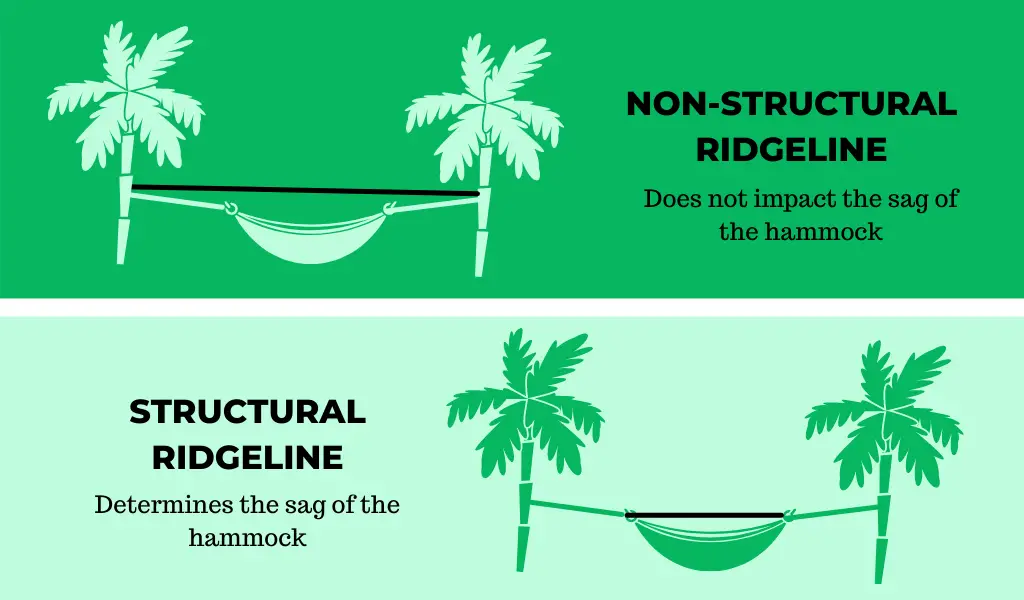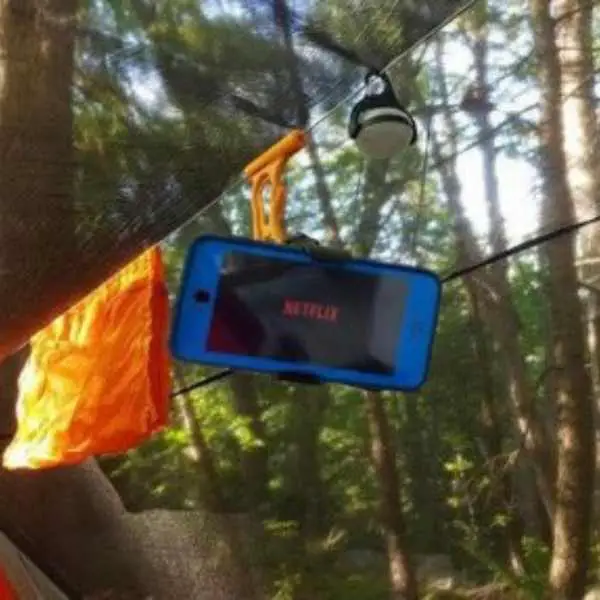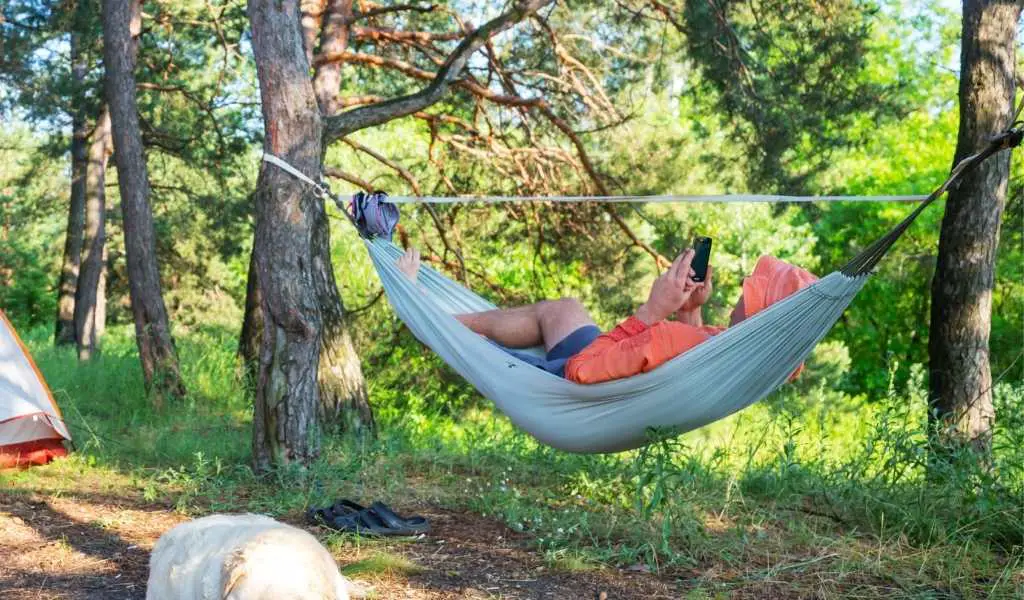Disclaimer: As an affiliate I may earn a commission on any qualifying purchases, including those from Amazon.com, at no extra cost to you – read more.
If you’re new to hammocking, you’ve probably heard the term ‘ridgeline’ being thrown around, but you may not be too sure what exactly it is.
In this guide, I’ll explain exactly what a ridgeline is, why you might consider using one and what to look for when buying ridgeline.
- What is a Hammock Ridgeline?
- Do I Need to Use a Ridgeline?
- Ridgeline Material
- Fixed vs Adjustable Ridgeline
- What’s the Best Ridgeline?
- How Long Should a Hammock Ridgeline Be?
- Benefits of a Hammock Ridgeline
- Best Ridgeline Accessories
- Can You Use a Hammock Ridgeline for a Tarp?
- Does My Hammock Stand Need a Ridgeline?
- Tips For Setting Up a Ridgeline
- Best Ridgeline Knots
What is a Hammock Ridgeline?
A hammock ridgeline is a piece of cord that runs across the top of a hammock. There are two types of ridgeline: non-structural and structural.
A non-structural ridgeline is used to suspend a bug net (or sometimes a tarp) above the hammock, it is independent of the hammock and does not impact its structure. A non-structural ridgeline will usually run from tree to tree.
A structural ridgeline is attached directly to the hammock with the purpose of does changing the hammocks structure. It runs between the rings of the hammock and helps you get the optimum amount of sag.
Keep reading for more of the key differences between the two types of ridgeline.

Do I Need to Use a Ridgeline?
No, you don’t need to use a ridgeline in order to get your hammock set up correctly. Providing the trees are the correct distance apart, you should be able to get the right amount of sag to have a comfortable night.
However, a ridgeline is beneficial when you can’t find the optimum tree distance, allowing you to hang your hammock over longer distances whilst maintaining the right sag.
In addition, you’ll benefit from somewhere to hang your gear, less stress on your hammock and something to hold on to when stumbling around at night.
The only real downside of a ridgeline is the minimal extra weight of the cord and the time it takes to set it up which will reduce with practice.
Ridgeline Material
There are typically two materials that will be used for a ridgeline:
- Amsteel Cord – This is the most commonly used material because it’s easy to get hold of, very cheaper and more than strong enough for a hammock ridgeline. It is made from Dyneema which is another popular choice for ridgelines and has similar properties. Amsteel has a break strength of around 725kg.
- Dynaglide – This has a lower break strength than Amsteel (around 450kg) but is also much lighter to carry.
- Paracord – If you’re using a non-structural ridgeline that doesn’t need to support your weight, you may opt for a lightweight paracord. However, this might be a bit stretchy for a structural ridgeline, especially when wet.
Fixed vs Adjustable Ridgeline
Structural ridgelines that attach directly to your hammock can be fixed or adjustable.
- A fixed ridgeline is a set length and once attached it cannot be changed. The sag of the hammock will be fixed according to the ridgeline length.
- An adjustable ridgeline will have a mechanism for changing its length. This will usually be a knot, ring or whoopie sling.
With an adjustable ridgeline, you can change the sag of the hammock, even after it has been set up. This allows you to adjust the sleeping angle until you get the perfect position.
This terminology does not apply to non-structural ridgelines as these have no impact on the sag anyway.
What’s the Best Ridgeline?
I recommend Samson Amsteel Blue as the best ridgeline cord to use.
It’s one of the strongest cords available with a 725kg (1600lb) break strength, plus it splices really well so you’ll find it easy to work with.
It’s not the lightest of all cords, however you won’t need to be carrying much so it will add minimal weight to your gear.
This particular product doesn’t come with any accessories, so you’ll need to learn the correct knots as below.

How Long Should a Hammock Ridgeline Be?
The perfect sag for a hammock is often touted at around 30 °. In order to achieve this, a hammock ridgeline should be set at 83% of the hammock’s total length.
For example, if you have an ENO SingleNest which is 9’3” (112 inches), the ridgeline will need to be 7’9” (93 inches).
This is not set in stone as you need to adjust the sag according to what you find comfortable, but it gives you a good starting point to aim for.
Benefits of a Hammock Ridgeline
There are actually a huge range of benefits to using a hammock ridgeline, here is a run down of the key ones:
- Get the perfect sag – Sag is important because it determines how comfortable you’ll be at night. The angle should be around 30° but you can adjust this to your needs. The sag will be determined by the distance between the trees, but with a structural ridgeline you can maintain your preferred sag no matter what the distance is.
- Hang in trees that are father apart – Finding the perfect spot to hang isn’t easy, sometimes the perfect trees might be too far apart, but with a structural ridgeline, the distance doesn’t matter as long as you can maintain 0.5m from the ground.
- Reduces pressure on your hammock – When hanging without a structural ridgeline, it exerts pressure to the fabric of your hammock which can damage it over time, especially if hanging between long distances. With a ridgeline, the pressure is applied to the cord rather than on your hammock.
- Hold up bug net – Both a structural and non-structural ridgeline can be used to hang up a bug net to keep away the bugs and any potential disease they may have at night.
- Keep your gear organised – A ridgeline is great for hanging your gear and keeping things organised off the ground. Anything can be hung up with the use of a carabiner, although there are a range of other ridgeline accessories that you might want to consider below.
- Hang on to it at night – The final thing worth mentioning is that the ridgeline can be used as an aid when walking around at night, this is helpful if you need to pop to the toilet in the dark.
Best Ridgeline Accessories
As we’ve established, you can take full advantage of your ridgeline to organise and store your gear.
Here are a few ridgeline accessories that might come in handy:
Multi-Purpose Tactical Pouch

If you’re looking to limit the amount of equipment you have to carry, this multipurpose organiser is a better option as it can also be used whilst on the go.
It has a handy carabiner clip built into the top of the organiser, this can be clipped on to your ridgeline for easy access or onto your backpack or belt whilst trekking.
It can easily hold your passport, wallet, keys, credit card and coins in a dedicated pouch.
Hammock Ridgeline Organiser

This ridgeline organiser is designed especially for use in camping hammocks.
Made from 210T nylon, it’s durable for the outdoors and can still be used on rainy days.
It’s lightweight and compact to carry, but when set up has toom for everything you need including your phones, headphones, glasses, keys and other small objects.
Hangtime Hook

The hangtime hook is perfect for holding your phone on the ridgeline for easy viewing in your hammock.
It has adjustments on the level, horizontal and vertical axis which means you can still lie diagonally in your hammock as you’re supposed to and get a good viewing angle.
Of course, you don’t need to have dedicated equipment, you can hang anything from your ridgeline with a good carabiner clip and the willpower to do so.
Can You Use a Hammock Ridgeline for a Tarp?
Ideally, you will not use the same ridgeline for your hammock and your tarp.
Stick to a structural ridgeline attached to your hammock for keeping the structure, then a separate ridgeline for your tarp.
This will allow you to maximise the space under your tarp to manoeuvre around.
Does My Hammock Stand Need a Ridgeline?
When using a hammock stand, you usually don’t need a structural ridgeline as the hammock should hang directly from the hooks.
In this instance, a ridgeline will make little difference to the sag.
If you’re using a ridgeline for other purposes, such as to hang your gear on or to support a bug net, then it’s perfectly fine.
You’ll need to check that the stand is suitable for a ridgeline, some have a ridge beam across the
Tips For Setting Up a Ridgeline
Here are some top tips to bear in mind when setting up a ridgeline:
- Your ridgeline should be about 83% of the length of your hammock, use this as a guide.
- Leave the ridgeline attached to your hammock, there is no need to remove it if you’ll be using it every time.
- If using an adjustable ridgeline, keep a note of the optimum length for future reference.
- It’s important to keep a lot of tension in the ridgeline, but if there is no movement at all then it’s probably over tight.
Best Ridgeline Knots
When attaching a fixed ridgeline, you’ll usually use a cord with a spliced loop through the loop of the hammock before putting the hammock up.
For adjustable ridgelines, there are three main methods you can use:
- Knots (Taut line hitch is a good choice)
- Ring
- Whoopie Sling
This YouTube video has a good overview of attaching your ridgeline with a whooper sling.


